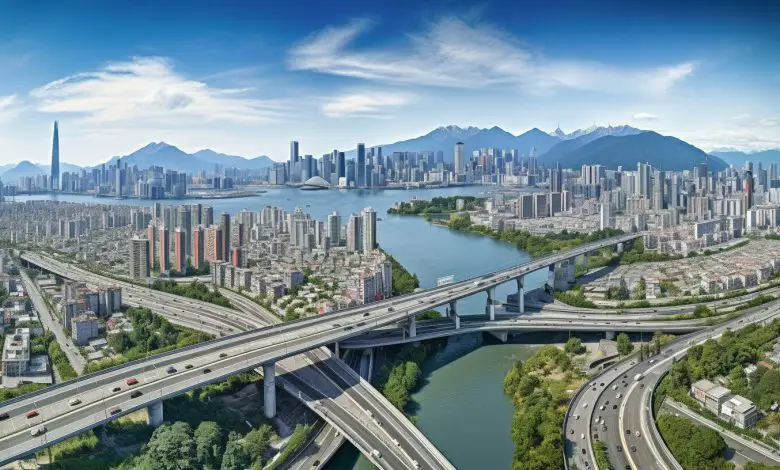Exploring About China Economy: A Comprehensive Guide

Welcome to our comprehensive guide on the China economy, where we delve into the complexities and key aspects of one of the world’s largest economies. In this book, we provide an in-depth analysis of China’s economic structure, evolution, and key reforms since 1978. Whether you’re a business leader, investor, policymaker, student, or simply curious about China’s economy, this guide is designed to give you a thorough understanding of its intricacies.
Key Takeaways:
- China’s economic growth since 1978 has been remarkable, positioning it as one of the world’s largest economies.
- The dual urban-rural society in China poses unique challenges and opportunities for economic development.
- The property market in China plays a significant role in driving overall economic growth.
- Debt accumulation in China is a pressing issue that requires careful attention and consideration of its implications.
- China’s environmental challenges are being addressed through its transition to a more sustainable economic model.
Understanding China’s Economic Evolution
Over the years, China’s economy has witnessed rapid growth, driven by various factors such as government policies, economic reforms, and changing market dynamics. The country’s economic evolution has been characterized by impressive milestones and a shift towards a more market-oriented system.
China’s remarkable economic growth can be attributed to the implementation of key policies, such as the reform and opening-up policy initiated in 1978. This policy aimed to liberalize China’s economy, encourage foreign investment, and promote domestic entrepreneurship. As a result, China experienced a surge in foreign direct investment, which fueled its economic development.
China’s economic growth has been nothing short of extraordinary, with an average annual GDP growth rate of around 10% over the past four decades.
China’s economic development has also been driven by its ability to adapt to changing market dynamics. It has leveraged its large population and labor force to become a global manufacturing hub, attracting multinational corporations and driving exports. Additionally, China has invested heavily in infrastructure development, creating a solid foundation for sustained economic growth.
As China continues to evolve economically, it is crucial to understand the country’s economic policies, trends, and challenges. This comprehensive guide delves into these aspects, providing valuable insights for business leaders, investors, policymakers, students, and anyone interested in understanding China’s economy.
The Dual Urban-Rural Society
China’s economic landscape is shaped by a dual urban-rural society, where distinct market dynamics exist between urban and rural areas. This unique characteristic plays a significant role in the overall economy of the country. In urban areas, we find bustling cities, advanced industries, and a rising middle class. On the other hand, rural regions are characterized by agriculture-based economies and a predominantly lower-income population.
The Chinese market, influenced by this urban-rural divide, exhibits varying consumption patterns, investment opportunities, and government policies. Urban areas attract more foreign direct investment and are hubs of technological innovation, while rural areas rely heavily on agriculture and face challenges such as limited access to education, healthcare, and infrastructure.
China has implemented economic reforms to bridge the gap between urban and rural areas, aiming to foster balanced development and promote social inclusivity. These reforms include initiatives to improve rural infrastructure, modernize agriculture, and enhance access to education and healthcare for rural residents. The government has also implemented policies to stimulate rural entrepreneurship and encourage the flow of resources from urban to rural areas.
The Impact of China’s Economic Reforms
The Chinese government’s commitment to reducing disparities between urban and rural areas has yielded positive results. Over the years, we have witnessed improvements in rural infrastructure, increased agricultural productivity, and a rising standard of living for rural residents. These economic reforms have enabled rural communities to benefit from the country’s overall economic growth and have contributed to poverty reduction.
However, challenges persist. Despite progress, the dual urban-rural society remains a complex issue. Income disparities, limited access to social services, and inadequate rural financial systems continue to pose obstacles to achieving balanced development. The government’s ongoing efforts to address these challenges and promote sustainable growth in both urban and rural areas are crucial for achieving long-term economic stability in China.
| Key Features of China’s Dual Urban-Rural Society | Implications for the Chinese Economy |
|---|---|
| Income disparities between urban and rural areas | Affects consumption patterns and economic inequality |
| Limited access to education and healthcare in rural regions | Impedes human capital development and productivity growth |
| Reliance on agriculture in rural areas | Challenges in diversifying rural economies and stimulating growth |
| Migration from rural to urban areas | Impacts labor supply and urban infrastructure demands |
Despite these challenges, the Chinese government’s commitment to addressing the dual urban-rural society reflects a dedicated effort to achieve a more equitable and sustainable economic development model. By investing in rural areas, promoting social welfare, and implementing policies that bridge the urban-rural divide, China aims to create a more harmonious society and foster balanced economic growth for the benefit of all its citizens.
China’s Property Market
The property market in China has experienced significant growth and has become a crucial component of the country’s economy. With rapid urbanization and increased demand for housing, China’s real estate sector has flourished, contributing to economic expansion and job creation. The market has been driven by factors such as population growth, rising incomes, and government policies aimed at promoting homeownership.
A key characteristic of China’s property market is the presence of both residential and commercial segments, with each having its own dynamics. Residential properties have been in high demand, fueled by a growing middle class and increasing urban population. This has led to soaring housing prices, especially in major cities like Beijing and Shanghai, making homeownership a challenge for many.
“China’s property market has witnessed a rapid increase in prices, leading to concerns of a potential real estate bubble.”
The government has implemented various measures to regulate the property market and address concerns of a potential bubble. These include tightening borrowing requirements, imposing purchase restrictions, and increasing housing supply. Despite these efforts, the market continues to face challenges, such as oversupply in some regions and speculative investment activities.
| Property Market Data |
|---|
| Housing prices have increased by an average of 7.9% per year from 2010 to 2020. |
| In 2020, total property investment amounted to $1.80 trillion, a 7% increase from the previous year. |
| Residential property sales reached 1.40 billion square meters in 2020, reflecting a 3% increase compared to 2019. |
In conclusion, China’s property market plays a crucial role in the country’s economy, driving growth and contributing to employment opportunities. However, it also presents challenges such as soaring housing prices and the risk of a real estate bubble. Government regulations and efforts to address these issues are ongoing, as the authorities strive to maintain stability and sustainable development in the property sector.
Debt Accumulation and Implications
Debt accumulation has been a concern in China, and its implications for the economy are a topic of significant interest. As of 2021, China’s total debt-to-GDP ratio stands at around 280%, raising concerns about its sustainability and potential risks. The rapid growth of debt in recent years, driven by both corporate and government borrowing, has fueled worries about its impact on financial stability and economic growth.
One of the main implications of high debt levels is the potential risk of a financial crisis. Excessive debt can lead to increased vulnerabilities within the banking system, making it more susceptible to shocks. If not managed effectively, a debt crisis can have far-reaching consequences, including a slowdown in economic growth, financial market instability, and a decline in investor confidence.
| Year | Total Debt | GDP |
|---|---|---|
| 2010 | 176% | USD 6.1 trillion |
| 2015 | 250% | USD 11.2 trillion |
| 2020 | 280% | USD 16.6 trillion |
Another implication of high debt accumulation is the potential strain it puts on fiscal resources. Servicing debt requires a significant portion of government revenues, diverting funds that could be used for productive investments, social welfare, or infrastructure development. Moreover, high debt levels can limit the government’s ability to implement expansionary fiscal policies during economic downturns, potentially hindering efforts to stimulate growth.
China’s debt situation is a delicate balancing act. On one hand, debt has been instrumental in driving economic growth and financing infrastructure development. On the other hand, the rising debt poses risks that need to be carefully managed to maintain financial stability and sustainable growth.
Addressing the issue of debt accumulation requires a comprehensive approach, combining prudent fiscal management, structural reforms, and targeted measures to reduce leverage. Efforts to improve financial regulation, promote transparency, and strengthen the banking sector’s resilience are key in mitigating the risks associated with high debt levels. Additionally, encouraging innovation, fostering sustainable development, and rebalancing the economy towards consumption and services can contribute to reducing China’s reliance on debt-fueled investment.
Environmental Challenges and Sustainability
As China undergoes an economic transition, it must address critical environmental challenges to ensure long-term sustainability. The country’s rapid growth and industrialization have taken a toll on its natural resources and ecosystems. China faces issues such as air pollution, water scarcity, and greenhouse gas emissions, which pose significant threats to public health and the environment.
To tackle these challenges, China has implemented various measures and policies. For instance, the government has introduced stricter environmental regulations, encouraging industries to adopt cleaner technologies and practices. China is also investing heavily in renewable energy sources, such as solar and wind power, aiming to reduce its reliance on fossil fuels and decrease carbon emissions.
“China’s commitment to environmental sustainability is evident in its ambitious targets for carbon neutrality”, said Dr. Liu, an environmental expert.
“By 2060, China aims to achieve carbon neutrality and peak carbon emissions before 2030. This demonstrates China’s determination to transition towards a greener and more sustainable economy.”
| Environmental Challenges | Sustainability Measures |
|---|---|
| Air pollution | – Implementation of stricter emissions standards – Promotion of clean energy sources |
| Water scarcity | – Water conservation initiatives – Improved water management practices |
| Greenhouse gas emissions | – Investments in renewable energy – Promotion of energy efficiency |
China recognizes that achieving environmental sustainability requires international cooperation. The country actively participates in global efforts, such as the Paris Agreement, to combat climate change. Additionally, China’s emphasis on sustainable development aligns with its economic transition, as it seeks to balance growth with environmental preservation.
Conclusion
Addressing environmental challenges is crucial for China’s long-term economic resilience and global leadership. By investing in sustainable practices and technologies, China aims to create a greener future while maintaining economic growth. As the country continues its economic transition, it remains committed to achieving both economic prosperity and environmental sustainability.
China’s Role in the Global Economy
China’s economic growth and transition have positioned it as a significant player in the global economy, with far-reaching implications. As the world’s second-largest economy, China’s influence extends beyond its borders, shaping global trade and investment patterns. With its vast consumer market and growing middle class, China offers immense opportunities for businesses and investors.
China’s economic transition from an export-oriented manufacturing powerhouse to a more balanced and domestically driven economy has brought about notable changes in global supply chains. The country’s shift towards higher value-added industries, technological innovation, and services has fueled its rise as a global leader in various sectors.
The Belt and Road Initiative
An important aspect of China’s global economic presence is its ambitious Belt and Road Initiative (BRI). This massive infrastructure and development project aims to enhance connectivity and promote trade and investment between China and countries along the ancient Silk Road routes. With investments in transportation, energy, and telecommunications infrastructure, the BRI facilitates closer economic ties between China and its partner countries, opening up new markets and opportunities.
China’s expanding presence in international institutions and its active participation in global economic governance also reflect its growing role in the global economy. Through initiatives like the Asian Infrastructure Investment Bank (AIIB) and the Shanghai Cooperation Organization (SCO), China seeks to shape the rules and norms of the global economic order.
As China continues its economic transition and seeks to address challenges such as environmental sustainability and income inequality, its role in the global economy will undoubtedly evolve. Understanding China’s economic landscape is crucial for businesses, governments, and individuals alike, as it offers invaluable insights into the opportunities and risks associated with engaging with the world’s most populous nation.
| Key Takeaways: |
|---|
| China’s economic growth and transition have positioned it as a significant player in the global economy. |
| The Belt and Road Initiative facilitates closer economic ties between China and partner countries. |
| China’s expanding presence in international institutions reflects its growing role in the global economic order. |
| Understanding China’s economic landscape is crucial for businesses, governments, and individuals. |
Current Economic Trends and Recovery
Explore the latest economic trends shaping China’s future as it navigates reforms and recovers from recent economic challenges.
China’s economy has shown remarkable resilience in the face of global uncertainties and internal challenges. Despite the impact of the COVID-19 pandemic, the Chinese government’s proactive measures and targeted stimulus policies have facilitated a steady recovery. Notably, one of the key factors contributing to this recovery is the ongoing economic reforms aimed at promoting sustainable and inclusive growth.
As China transitions towards a more consumer-driven economy, there has been a shift from an export-oriented model to domestic consumption and innovation-driven growth. This shift is reflected in the strong performance of China’s e-commerce sector, which has witnessed exponential growth in recent years. The rise of digital platforms and online shopping has not only provided convenient access to goods and services for Chinese consumers but has also fueled entrepreneurial opportunities and job creation.
In addition to the shift towards a consumer-driven economy, China’s economic reforms have also focused on enhancing financial stability, reducing excessive debt levels, and improving the efficiency of the financial sector. These reforms aim to address potential vulnerabilities and lay the foundation for sustainable long-term growth. The establishment of stricter regulations and the implementation of risk management measures have contributed to the stability of China’s financial system and restored investor confidence.
Overall, China’s current economic trends reflect a resilient economy that is adapting to new challenges and laying the groundwork for sustainable growth through comprehensive reforms. As China continues to navigate these reforms and recover from recent economic challenges, it is crucial to monitor and analyze the evolving trends to gain insights into the future trajectory of the world’s second-largest economy.
Conclusion
In conclusion, the China economy is a dynamic and evolving force with a significant impact on the global stage, fueled by robust GDP growth and ongoing economic reforms. The comprehensive guide “Exploring About China Economy: A Comprehensive Guide” provides valuable insights into the complex economic structure of China. It analyzes the country’s economic evolution since 1978, highlighting the key reforms and policies that have shaped its development.
One of the key factors driving China’s economic growth is its impressive GDP. With a current GDP of over $16 trillion, China has become the world’s second-largest economy. This exponential growth is a testament to the country’s determination and strategic economic planning.
The guide also sheds light on the ongoing economic reforms in China. These reforms have played a crucial role in transforming the Chinese economy and paving the way for sustainable development. From liberalizing trade policies to encouraging innovation and entrepreneurship, China has demonstrated its commitment to modernization and global integration.
Furthermore, the guide delves into various aspects of China’s economy, such as the dual urban-rural society and the challenges it poses. It explores the property market, debt accumulation, and the environmental challenges that China is currently facing. By addressing these issues, China is actively working towards creating a more balanced and sustainable economy.
For business leaders, investors, policymakers, students, and anyone interested in understanding China’s economy, “Exploring About China Economy: A Comprehensive Guide” is an invaluable resource. It provides a comprehensive analysis of the past, present, and future trends in China’s economy, equipping readers with the knowledge needed to navigate this dynamic and rapidly changing landscape.
FAQ
What is “Exploring About China Economy: A Comprehensive Guide”?
“Exploring About China Economy: A Comprehensive Guide” is a book that provides an in-depth analysis of China’s complex economic structure, evolution, and key reforms since 1978.
Who is this book recommended for?
This book is recommended for business leaders, investors, policymakers, students, and anyone interested in understanding China’s economy.
What topics are covered in the book?
The book covers various aspects of the Chinese economy, including the dual urban-rural society, the property market, debt accumulation, environmental challenges, China’s role in the global economy, and the sustainability of its economic development.
Are there any articles included in the book?
Yes, the book also includes articles discussing China’s economic recovery, inflation, housing market, debt levels, and monetary policy.
Source Links
- https://www.routledge.com/Making-Sense-of-Chinas-Economy/Wang/p/book/9781032317045
- https://www.jpmorgan.com/insights/global-research/economy/china-economy
- https://www.routledge.com/Routledge-Studies-on-the-Chinese-Economy/book-series/SE0706








